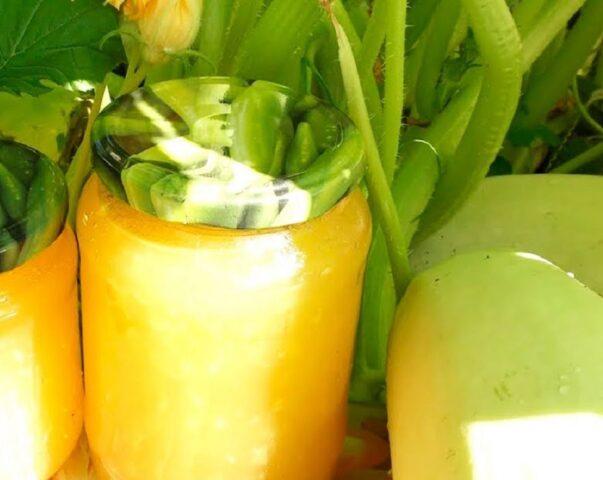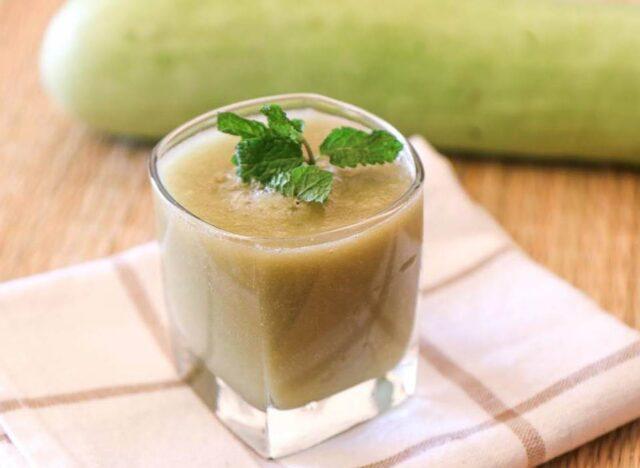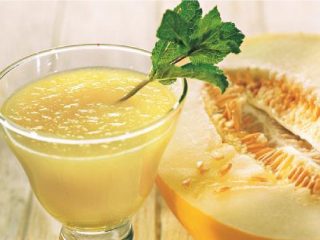Content
In addition to traditional methods of processing vegetables, you can prepare zucchini juice for the winter. Both young and overripe, illiquid fruits are suitable for this purpose. The drink in its pure form is not canned; it does not have a pronounced taste or aroma. The main value of zucchini is its rich chemical composition, and fruits, berries or spices are additionally used to enhance the taste.
Subtleties of cooking
Any zucchini is suitable for processing for the winter: green, ripe or overripe. The taste and nutritional value of the vegetable at any stage of ripeness is the same. The preparation of raw materials for conservation will differ. A mandatory requirement for vegetables and other components of the recipe is good quality.

You can make juice for the winter sweet if you add fruits and citrus fruits, or salty
The taste and smell of zucchini are unexpressed, one might say that it is completely absent. Preparing for the winter only from vegetables will turn out bland with the smell of freshly cut grass.
The culture bears fruit abundantly. Several zucchini bushes produce quite a large number of fruits.There are enough of them for storing for the winter in marinated, salted form or for preparing caviar. From the remaining raw materials you can make a vitamin or dessert drink. Zucchini is combined with all herbs without exception, it all depends on taste preferences. Sweet juice can be prepared with the addition of almost all available fruits and citrus fruits.
The optimal ingredient for this purpose is lemon; it will add additional flavor to the drink. In the absence of citrus, you can use citric acid. It is not advisable to add vinegar, even if it is fruity, such as apple or grape.
Preparing Ingredients
Any variety of zucchini is suitable for making juice for the winter. Not only young and ripe ones are processed, but also overripe, illiquid specimens.
Preparing vegetables:
- Wash the surface under running water. Particular attention is paid to contaminated areas.
- Remove any remaining moisture with a clean kitchen towel or cloth napkin.
- The peel and core of young zucchini are not removed. Their seeds are soft and the fibrous structure is dense. Vegetables are suitable for making not only pure juice, but also with pulp.
- The peel is removed from ripe fruits. Cut them lengthwise and remove seeds.
- For overripe ones, in addition to the top layer, the entire core with seeds is cut off. It is dry and bitter, there is no juice in it, but it can spoil the taste.
- If the quality of individual areas is in doubt, they are soft, with an unpleasant odor or signs of rotting, they are removed to normal, elastic pulp.
The workpiece is cut into pieces. If you use a juicer, the pieces should easily fit into the neck of the household appliance.To obtain a preparation for the winter with pulp, the raw material is molded into small cubes.

It is convenient to remove the peel using a special potato peeler
Preparing containers
No matter how carefully the raw materials are prepared and subjected to heat treatment, the workpiece will not stand for a long time for the winter if it is sealed in untreated containers. Roll the zucchini only into sterile jars or bottles with a wide neck fitted for a screw cap. Before disinfection, the containers are washed with hot water with the addition of baking soda, and residues are removed by repeated rinsing.
There are several ways to disinfect containers:
- For a couple. Pour water into the pan to fill 1/3 of the volume, place a wire rack on top, and place the jars on it, neck down. When the liquid boils, the inside of the container will become covered with steam. The jars are left to sterilize for 15-20 minutes.
- In the microwave. While cans can be steamed, this is difficult to do for bottles. They are washed thoroughly with dish soap. Turn upside down to drain and place in the microwave for 10 minutes.
- In the oven. The washed and dried containers are placed on a baking sheet and the mode is set to 120-150 0C

Banks are sterilized for 10 minutes
Metal lids are also subject to treatment. They are washed with baking soda, placed in a container, and filled with cold water until it completely covers them. Place on the stove and leave for five minutes after boiling. The fire is turned off. Remove the lids from the boiling water immediately before rolling.
How to make zucchini juice for the winter at home
A juicer is often used as equipment, then the drink will be transparent without fiber impurities. If you don’t have a household appliance, you can get juice from zucchini by boiling finely chopped raw materials.In the latter case, you will get a preparation for the winter with pulp. All recipes with free dosage and composition. You can add your own ingredients, especially herbs and the amount of sugar. If the zucchini comes with fruit, the proportions also depend on desire.
Classical
Components:
- zucchini – 1.5 kg;
- black currant leaves – 3-4 pcs.;
- cloves – optional, can be replaced with mint or lemon balm;
- salt - to taste;
- citric acid – ¼ tsp. or 2 slices of lemon.
Preparing juice for the winter:
- The zucchini is passed through a juicer.
- The resulting liquid is poured into a cooking container, spices and salt are added.
- Place washed and dried currant leaves at the bottom of the container.
- Brew the drink for 15 minutes. Add citric acid or squeeze out citrus.
- Pour boiling liquid into the container in a thin stream so that the leaves remain at the bottom.
- Place a kitchen towel on the bottom of a wide pan, place the workpiece, cover with lids, and add water to the hangers.
- Sterilize after boiling for 15 minutes.
- Sealed and insulated.

When serving, natural juice can be decorated with a sprig of mint
With apples
The recipe is the simplest: take equal quantities of zucchini and apples, add sugar to taste. For 1 liter of juice you will need citric acid on the tip of a knife.
How to make for the winter:
- The apples are washed, cut in half, and the hard core with seeds is removed.
- Fruits and vegetables are passed through a juicer.
- Measure the amount of liquid for dosing the preservative.
- Pour into a cooking container, add sugar, approximately 100 g per 1.5 l. When it dissolves, adjust the taste.
- Boil the drink for 15 minutes.
Pour into containers and seal.

Zucchini drink with a high content of vitamins and chemical elements is good for health at any time of the year.
Zucchini juice for the winter with orange
Recipe for winter juice with zucchini pulp:
- Vegetables are cut into small pieces into a cooking container and left for 15 minutes so that the preparation releases juice.
- Set to the lowest temperature setting and stir constantly. Blanch until the slices soften.
- Beat the zucchini with a mixer.
- Filter through clean gauze (in several layers), carefully squeeze out the pulp.
- Take one orange per 300 ml of zucchini liquid, remove the zest from it using a fine-mesh grater, then squeeze out the juice.
- All ingredients are combined. Add sugar to taste. Cook for 10 minutes.
The boiling juice is poured into jars and closed.

Vitamin cocktail can be served as a tonic drink with ice cubes
Storage rules and periods
Zucchini and accompanying components undergo heat treatment before sealing in containers. A preservative must be added to the juice. If the containers are clean and sterilized, the drink will not lose its nutritional value for 2-3 years. In winter, store the zucchini preparation in an unlit place so that under the influence of ultraviolet radiation most of the useful chemical elements of the composition do not disintegrate.
You can place containers with juice in the pantry or on a closed loggia. In the latter case, the temperature in winter should not fall below zero. At sub-zero temperatures, glass jars may burst. The ideal option for storing zucchini is a basement with low air humidity and temperatures up to +80 C.
Conclusion
Zucchini juice for the winter is one of the simplest ways to process vegetables.The raw materials are not subjected to prolonged boiling, therefore they completely retain all vitamins and useful chemical elements. As additional components, you can use herbs, citrus fruits and fruits in any proportion.









Hello, the pulp must be removed from the finished zucchini juice